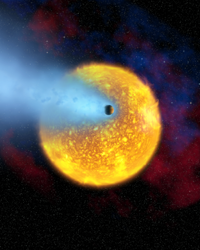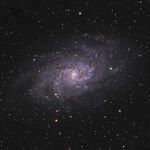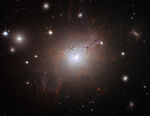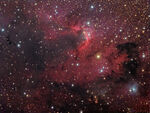| Constellations (9) | |
|---|---|
| Andromeda, Cassiopeia, Cepheus, Equuleus, Lacerta, Pegasus, Perseus, Triangulum Boreale, Vulpecula | |
| Nomenclature | |
| Abbreviation | Tes |
| Genitive | Testudi |
| Pronunciation | Name: /'tes•tū•dō/ Genitive: /'tes•tū•dī/ |
| Symbolism | the turtle |
| Geometry | |
| Midpoint right ascension | 02h 00.22m |
| Midpoint declination | +45° 29.69' |
| Northernmost border | +88° 39.83' |
| Southernmost border | +02° 19.54' |
| Westernmost border | 18h 57.11m |
| Easternmost border | 09h 03.33m |
| Quadrant | NQ1 |
| Crossed by | Spring meridian Summer meridian |
| Bordering caelregios | Araneus (SE) Avis (E/N/W) Hippocampus (S) Tarandus (W) |
| Segments | 86 |
| Area | 4316.604 sq. deg. (5th) |
| Proportion of the sky | 104.637‰ |
| Average constellation area | 479.623 sq. deg. (7th) |
| Stars | |
| Named stars | 39 |
| Stars in the figure | 12 |
| Naked eye stars (m < 6.50) |
390 |
| BF stars | 403 |
| Bright stars (m < 3.00) |
20 |
| Brightest star | Mirfak (1.82m) |
| Nearby stars (D < 10.00 pc, 32.62 ly) |
17 |
| Nearest star | Ross 248 (3.16 pc, 10.30 ly) |
| Messier objects | 10 |
| Visibility | |
| Full visibility range | 90°N–12°S |
| Partial visibility range | 12°S–87°S |
| Midnight culmination date | October 23 |
Testudo is a caelregio located in the first quadrant of the northern hemisphere at its midpoint, but it extends into the fourth and second quadrants. The northernmost border is just 80 arcminutes away from the celestial north pole, making this a near-circumpolar caelregio. Testudo is divided into nine constellations (listed in the infobox).
Testudo contains many examples of prototype variables and eclipsing binaries such as Cepheids and Algol, as well as many notable galaxies, nebulae, and star clusters such as the Andromeda Galaxy and the Double Cluster. This caelregio contains the famous asterism "Square of Pegasus." Testudo also contains the first exoplanet discovered around a sun-like star (51 Pegasi), the first sun-like star discovered to have multi-planet system (Upsilon Andromedae), and two most studied transiting exoplanets (Osiris (HD 209458 b) and Teumesia (HD 189733 b)).
Name and symbolism[]
Testudo is directly named after the former constellation where it is now part of Pisces in the neighboring caelregio Hippocampus. Testudo is originally named after the Latin word for turtle. It can be imagined that turtles are domesticated by the King (Cepheus) and the Queen (Andromeda), who ride horses (Equuleus) or even winged horses (Pegasus).
Notable stars[]
Bright stars[]
An F-type supergiant Mirfak is the Testudo's brightest star at a magnitude is 1.82, located in Perseus. Perseus also contains a B-type main sequence Algol (2.12m) in addition to Mirfak.
Mirach is a red giant located in Andromeda. Its magnitude is 2.06 and it is 197 light-years from Earth. Alpharatz is a B-type subgiant also located in Andromeda. Its magnitude is 2.07 and it is 97 light-years from Earth.
Schedar is a K-type giant star located in Cassiopeia. Its magnitude is 2.25 and it is 228 light-years from Earth. Gamma Cassiopeiae is a B-type subgiant also located in Cassiopeia. Its magnitude is 2.39 and it is 549 light-years from Earth. Alpha Cephei is a A-type subgiant located in Cepheus. Its magnitude is 2.44 and it is 49 light-years from Earth.
Enif is a K-type supergiant located in Pegasus. Its magnitude is 2.40 and it is 689 light-years from Earth. Scheat is a red giant also located in Pegasus. Its magnitude is 2.42 and it is 196 light-years from Earth. Markab is a B-type giant again located in Pegasus. Its magnitude is 2.50 and it is 133 light-years from Earth. Algenib is a B-type subgiant yet again located in Pegasus. Its magnitude is 2.83 and it is 391 light-years from Earth.
Alpheratz, Scheat, Markab, and Algenib make up the "Square of Pegasus," which is the most prominent autumn asterism.
Nearby stars[]
The red dwarf Ross 248 is the Testudo's nearest star at a distance of 10.30 light-years (3.16 parsecs), located in Andromeda.
Variable stars[]
The prototype variable star Delta Cephei can be found. Cepheids are used as standard candles to measure distance of stars in star clusters. The variability period of Cepheids depend on luminosities. When variability period is determined, then its luminosities can be assumed. Using luminosities and magnitudes seen by observer, then distances can be determined. Using this can even measure accurate distances where the distances are too great for current astrometric research to calculate, such as in other galaxies.
Another prototype variable star is Mu Cephei, also known as the Herschel's Garnet Star because of the garnet red color of the star. This star is a red supergiant and is one of the largest stars known. The star varies between magnitudes 3.62 to 5 over a period of 2 to 2.5 years.
Yet another prototype variable is Beta Cephei, also properly named Alfirk. The magnitude of this star varies between 3.15 and 3.21 with a period of 4.57163 hours. This star is also a triple star comprising a spectroscopic binary with a 8th magnitude optical companion.
Algol, which is a prototype variable star, is one of the best known eclipsing binaries and the second (non-nova) variable star discovered after Mira. Every 2 days, 20 hours and 49 minutes, the magnitude drops from 2.1 to 3.4 as the fainter star partially eclipses the brighter star, which lasts about 10 hours. To make it more precise, Algol is actually a triple star system.
Gamma Cassiopeiae is another prototype variable star that is also called "shell star." It is an eruptive variable star that varies irregularly in brightness from 2.20m to 3.40m. This star varies in average brightness by 40% every 50 years.
Another eclipsing binary is SS Lacertae, located in the open cluster NGC 7209. SS Lacertae orbits around the center of mass every 14.4 days. This eclipsing binary is unique because it turns on and off caused by inclination changes by the gravity of a tertiary star.
TX Piscium (19 Piscium) is another variable star. This red giant star varies brightness irregularly from magnitudes 5 to 6 in about 18 months.
Mulitple stars[]
Alpheratz is a binary star comprising of B-type subgiant and A-type main sequence stars. The orbital period around the center of mass is 96.7 days at an apparent separation about 24 milliarcseconds, which is only resolvable in large amateur telescopes. It also contains an optical companion ADS 94 B, which is a 10.8m G-type main sequence star. This companion is 89.3 arcseconds away from component A, which can be resolvable using the low-power binoculars but the star is too faint to be seen using this equipment.
An example of a multiple star system in Testudo is 85 Pegasi. The primary star 85 Pegasi A has a binary secondary companion 85 Pegasi B. It is speculated that a pair of super-Jupiter planets with masses of 5.4 and 9.1 MJ orbit the center of mass at an average distance of 18 and 29 AU respectively.
Planetary systems[]

HD 209458 b (Osiris, P30) in transit across its parent star, notice a blueish comet-like tail of escaping gases trailing the planet
As of 2015, there are more than five dozen exoplanets identified orbiting around more than 50 stars in Testudo. On October 6, 1995, astronomers found the first ever confirmed exoplanet around a normal star, named Bellerophon (51 Pegasi b, P13) around 51 Pegasi (P1 Tes); this was also the first hot Jupiter known.
Upsilon Andromedae (P2 Tes) has four giant exoplanets with orbital periods ranging from 4.6 days to about 38 years; the mass ranges from 1.27 to 6.67 MJ. Upsilon Andromedae became the first normal star discovered to have a multi-planet system.
Both HD 209458 (P3 Tes, in Pegasus) and HD 189733 (P6 Tes, in Vulpecula) contain transiting hot Jupiters (respectively Osiris (HD 209458 b, P30) and Teumesia (HD 189733 b, P161)) that were most studied of all exoplanets, especially their evaporating atmospheres. Another star with a transiting planet is HD 17156 (P10 Tes, in Cassiopeia), which has a very eccentric planet Thetis (HD 17156 b, P213). This star also has an unconfirmed planet Intercidona (HD 17156 c, P257) as well as two hypothetical planets beyond the orbits of known planets.
Kappa Andromedae (P44 Tes) contain a 12.8-Jupiter mass directly imaged super-Jupiter (named Ligdus (Kappa Andromedae b, P841)). It orbits nearly twice the distance between the Sun and Neptune.
Notable deep sky objects[]
Testudo contains the nearest spiral galaxy: the Andromeda Galaxy (M31, NGC 224), located in Andromeda. Andromeda contains two most famous examples of dwarf elliptical satellite galaxies: M32 (NGC 221) and M110 (NGC 205).
The Triangulum Galaxy (M33, NGC 598) is the second closest spiral galaxy located in Triangulum Boreale. Perseus contains two double clusters (both open clusters) which is the only constellation to contain double clusters. One double cluster contains NGC 869 (h Persei) and NGC 884 (χ Persei), which collectively designated C14.
Located in Perseus, there is the Seyfert galaxy NGC 1275 (also known as Perseus A) (C24), which is a member of the Perseus Cluster (Abell 426) which also includes NGC 1268. Located in Cassiopeia, there is Tycho's Supernova Remnant SN 1572 (B Cas) after the progenitor star exploded in 1572. This supernova was seen by Tycho Brahe.
This constellation also contains the California Nebula (NGC 1499), which is an emission nebula. Cepheus contains the Elephant's Trunk nebula (IC 1396), which is a concentration of interstellar gas and dust where stars form. In Andromeda, there is the Snowball Nebula (also known as the Blue Snowball Nebula) (NGC 7662, C22), which is an egg-shaped planetary nebula.
Pegasus contains Stephan's Quintet, which is one of the most compact galaxy group known. Four of the five galaxies in Stephan's Quintet form a physical association that will most likely end with all four galaxies merging together to form a giant elliptical galaxy. Also in this constellation, there are NGC 7479 (C44) and NGC 7741, which are barred spiral and spiral galaxies respectively. In Andromeda, we find the edge-on spiral galaxy NGC 891 (also known as the Silver Silver Galaxy) (C23) with HII nucleus and dust lanes, which can prominently be visible to a large telescope. NGC 891 is one of the sky's finest edge-on galaxies.
M15 (NGC 7078), also in Pegasus, is one of the densest globular clusters in the Milky Way Galaxy. This cluster contains a million old stars within a diameter of just 120 light-years.
Vulpecula contains the Coathanger (also known as Brocchi's Cluster or Al Sufi's Cluster) (Cr 399), which is an asterism clearly seen in binoculars. This constellation also contains the Dumbbell Nebula (also known as the Apple Core Nebula, Diablo Nebula, or the Double-Headed Shot) (M27, NGC 6853), which is a famous diffuse nebula.
In Cassiopeia, the Bubble Nebula (NGC 7635, C11), which is an HII region and emission nebula, can be found using an averted vision. Also in the same constellation, the Soul Nebula (also known as the Baby Nebula) (IC 1848) and the Heart Nebula are found using a telescope and are collectively known as "Heart and Soul." Both members of the pair are emission nebulae. Also in this constellation, there is the Pacman Nebula (NGC 281), which was named after its resemblance to the video game character Pac-Man.
The Garren Nebula (NGC 604), which is an emission nebula with massive HII region, can be found in the Triangulum Galaxy in Triangulum Boreale. This nebula is 1500 light-years or 460 parsecs across, 40 times the size of the Milky Way's Orion Nebula. This nebula is over 6300 times more luminous than the Orion Nebula. If the Garren Nebula is located at a same distance as the Orion Nebula from Earth, it would appear twice the size of the full moon and outshine Venus.
In Cepheus, the Iris Nebula (NGC 7023, C4) can be found. This "nebula" is actually a star cluster within the nebula LBN 487. The nebula is lit by a seventh magnitude star SAO 19158, making this a reflection nebula. This nebula is located 1300 light-years away and it is 6 light-years across. Another nebula in Cepheus is the Cave Nebula (Sh2-155, C9), which is a dim and very diffuse bright nebula within a larger nebula complex appearing like a deep cave through a telescope. Yet another nebula in this constellation is Gyulbudaghian's Nebula (HH 215), which is a variable reflection nebula powered by the variable star PV Cephei at its center.
In Lacerta, there is the prototype active galaxy BL Lacertae, which was thought to be an irregular variable star in the Milky Way Galaxy. This galaxy varies in magnitude just like a variable star, it varies between magnitudes 14 to 17 over a fairly small time periods. Another deep sky object in this constellation is the HII region Sh2-126.
Gallery[]
 The Andromeda Galaxy (M31, NGC 224) |
 The Triangulum Galaxy (M33, NGC 598) |
 The California Nebula (NGC 1499) |
 The Coathanger (also known as Brocchi's Cluster or Al Sufi's Cluster) (Cr 399) |
 The Double Cluster (NGC 869 (h Persei, right) and NGC 884 (χ Persei, left)) (C14) |
 The Heart Nebula (IC 1805) |
 The globular cluster M15 (NGC 7078) |
 The Bubble Nebula (NGC 7635, C11) |
 |
 The Seyfert galaxy NGC 1275 (also known as Perseus A) (C24) |
 Tycho's Supernova Remnant SN 1572 (B Cas) |
 The Iris Nebula (NGC 7023, C4) |
 The Elephant's Trunk Nebula (IC 1396) |
 The Garren Nebula (NGC 604), located in the Triangulum Galaxy |
 The Dumbbell Nebula (also known as the Apple Core Nebula, Diablo Nebula, or the Double-Headed Shot) (M27, NGC 6853) |
 The Cave Nebula (Sh2-155, C9) |
 The Perseus Cluster (Abell 426) |
 The Pacman Nebula (NGC 281) |
 The HII region Sh2-126 |
 The Snowball Nebula (also known as the Blue Snowball Nebula) (NGC 7662, C22) |
 The edge-on spiral galaxy NGC 891 (also known as the Silver Silver Galaxy) (C23) |
 The Soul Nebula (also known as the Baby Nebula) (IC 1848) |
Notable meteor showers[]
The Perseids (also called Testudids) peak between August 9–14 every year. This meteor shower is caused by the comet Swift-Tuttle. Up to 142 meteors per hour were visible on August 12, 2010. The most active Perseids in recorded history took place on August 12, 1972 when 292 meteors per hour were visible, roughly twice as active as the 2010 peak.
Visibility[]
In the northern hemisphere, Testudo is most prominent from mid summer till late fall. At mid-northern latitudes, about half of Testudo is circumpolar, therefore at least half of this caelregio can be visible all-year round. However in the mid-southern latitudes, only half of this caelregio can be visible at once, from mid winter till late spring.
Zodiac[]
Since the Sun never crosses Testudo, this is not a zodiacal caelregio.
| |||||